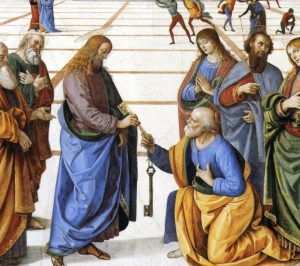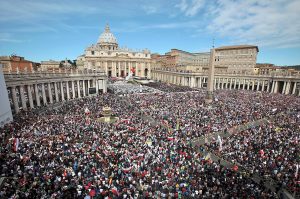“I am praying not only for these disciples but also for all who will ever believe in me because of their testimony. My prayer for all of them is that they will be one, just as you and I are one, Father… so they will be in us, and the world will believe you sent me” (John 17:20-21, NLT Bible)
On the night before He died, Jesus earnestly prayed to His Father to keep all His future believers one and united. It is a must if the whole world is to believe in Him.

Division causes confusion and weakness as proven by Paul to his advantage in the First Reading. He successfully sowed confusion between the Pharisee and Sadducee sects of Judaism over their division on the theology of life after death, thus he evaded their joint wrath for teaching about Jesus Christ.
With this in mind, in 50 AD (long before the Church complied the New Testament in 400 AD), Paul emphasized to his converts the importance of the continuity of tradition to keep the Church united. “So then, brethren, stand firm and hold to the traditions which you were taught by us, either by word of mouth or by letter.” (2 Thessalonians. 2:15)
Even as the last Gospel (the Gospel of John) was being written between 90-110 AD, the Church was already called Catholic, meaning universal or worldwide. In 107 AD, Bishop Ignatius of Antioch wrote to the Christians in Smyrna (modern-day Izmir, Turkey), “Wherever Jesus Christ is, there is the Catholic Church.” (Wikipedia Encyclopedia, https://en.wikipedia.org/wiki/Catholic_(term))
It is very poignant that it was in Antioch where Ignatius was Bishop, where the believers of Christ was first called Christians (Acts 11:26).
Elsewhere, we find these written confirmations in secular encyclopedias:
“St. Peter, of Bethsaida in Galilee, From Christ he received the name of Cepha, an Aramaic name which means rock .Prince of the Apostles, w
“ROMAN CATHOLICISM The largest of the Christian denominations is the Roman Catholic church. As an institution it has existed since the 1st century AD… the Roman church owes its existence to the life of Jesus Christ in the 1st century AD” (Comptons Encyclopedia, ©1995)
“Roman Catholic authority rests upon a mandate that is traced to the action of Jesus Christ himself, when he invested Peter and, through Peter, his successors with the power of the keys in the church. Christ is the invisible head of his church, and by his authority the pope is the visible head.” (Encyclopedia Britannica, ©1999)
“Roman Catholicism Christian church characterized by its uniform, highly developed doctrinal and organizational structure that traces its history to the Apostles of Jesus Christ in the 1st century AD.” (Encyclopedia Britannica, ©1999)
We Catholics are proud that our Church is the true one – AND RIGHTLY SO! And we love to hear the proof of it. But do we show the same love for her teachings? If she is the right one, do we stand with her against contraception, abortion, divorce and same-sex ‘marriage’? Do we follow her advice in choosing the morality of leaders who will run our country and help build the Kingdom of Jesus Christ?
Pentecost was when the Holy Spirit descended from the Father and the Son upon Mary and the Apostles, thus giving life to the Church. As our birthday gift to our Mother Church, let us give her and her Bridegroom Jesus Christ the gift of our obedience and unity.
From Word Today in the Philippines https://www.facebook.com/CatholicMassReflections



This Post Has 6 Comments
Just thinking out loud here. Christ seems to have extended his kingdom through Thomas . It was doing fine.
I read that the Apostle Thomas introduced India to Christ in about 50 AD. The Roman Catholic Church discovered that Christianity in Kerala India had already been in existence for about 1500 yrs.
The Portuguese arrived in Malabar in the mid sixteenth century. After that the focus seems to have been a conflict to impose Roman Catholicism on the already existing Christians. Nothing to do with advancing the Gospel. The more recent history seems to be a series of internal squabbles over power, not much else.
Again, please realize that none of this is meant in malice.
This from a short synopsis of the history:
The original tradition of the Syro-Malabar Nasranis was all but wiped out when the Portuguese acquired
dominance in Kerala, and denounced Nasrani Christianity as heretical. They imposed Western Catholic
rituals and liturgy and systematically suppressed the indigenous Indian church.
Archbishop Menezes of Goa, convened the Synod of Diamper in 1599. There he ordered all the texts of
the Syrian Nasranis to be burned. It seems as if he was remarkably successful as nothing has survived.
The purpose stated by Menezes was to erase all legacies of antiquity and Jewishness. Amongst several
accusations, the Nasranis were accused of not venerating images of saints and Biblical figures.
The oppressive rule of the Portuguese Padroado provoked a violent reaction on the part of the indigenousChristian community. The oppressive rule of the Portuguese Padroado provoked a violent reaction on the part of the indigenous
Christian community. The first solemn protest took place in 1653, known as the Koonan Kurishu Satyam
(Koonan Cross Oath). Under the leadership of Archdeacon Thomas, Saint Thomas Christians publicly
took an oath in Matancherry, Cochin, that,
"by the Father, Son and Holy Ghost that henceforth we would not adhere to the Franks, nor
accept the faith of the Pope of Rome"
Four months afterwards twelve elders of the church laid their hands on Malankara Mooppen
(Archdeacon) Thomas and ordained him as Mar Thoma I. The branch of the church that did not take the
oath and thus was affiliated with the Catholic Church was designated the Pazhayakuttukar, or ‘Old
faction’, while the branch affiliated with Mar Thoma was called the Puthankuttukar, or ‘New faction’.
Between 1661 and 1662, out of the 116 churches on record, the Old Faction held eighty-four churches,
while Mar Thoma I held thirty-two churches. The Syro-Malabar Catholic Church and Chaldean Syrian
Church (as they split off at a much later date) claim decent from the Old Faction. Those who continued
with East Syrian and Latin theological and liturgical tradition and stayed faithful to the Synod of Diamper
and the Roman Catholic Church became known as the Syro-Malabar Catholic Church.
http://www.anglicanfoundation.org/wp-content/uploads/2011/06/Saint-Thomas-Paper.pdf
STEVE RAY HERE: just returned from India and understand the history of the Catholic Church there. Saint Thomas established of the Catholic Church because that's the only church the apostles established. I don't deny that different countries fought and argued among themselves ecclesiastically but it was not different churches and sects like we see today and Protestantism. Those original Saint Thomas Catholics are still there today.
Protestantism is a whole Nother animal. It divides into schisms and factions with no regard for a visible unity which Jesus required in John chapter 17.
love this muuuwah ! #proudtobecatholic
I want to visit the tomb of Elisha
STEVE RAY HERE: We Will be visiting the tomb of Elisha in February 2020. You can visit my pilgrimage site at http://www.footprintsofgod.com. Even though it’s not mentioned in the itinerary, I don’t think, we are going to be visiting the Tomb of Elisha in Samaria.
STEVE RAY HERE: We Will be visiting the tomb of Elisha in February 2020. You can visit my pilgrimage site at http://www.footprintsofgod.com. Even though it’s not mentioned in the itinerary, I don’t think, we are going to be visiting the Tim of Elisha in Samaria.
STEVE RAY HERE: We Will be visiting the tomb of Elisha in February 2020. You can visit my pilgrimage site at http://www.footprintsofgod.com. Even though it’s not mentioned in the itinerary, I don’t think, we are going to be visiting the Tomb of Elisha in Samaria.
Not “insects” but ‘in sects’.
Comments are closed.